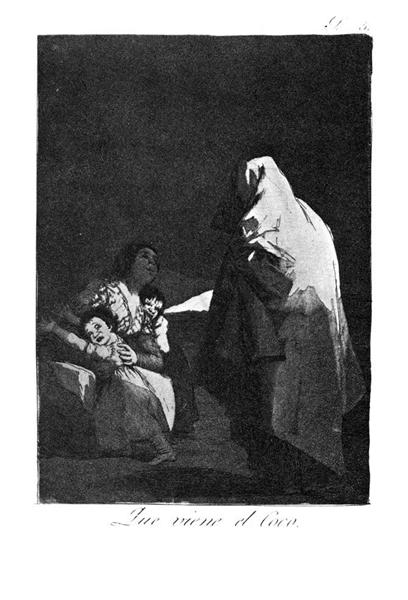Description
Francisco Goya’s work entitled “Here Comes the Bogeyman” from 1799, evokes a theme that transcends the everyday, introducing the viewer to a universe of unease and ambiguity. This oil on canvas reflects one of the less explored facets of the Aragonese master: his concern with childhood fears, fantasy and moral warning. Through a simplistic but meaningful composition, Goya delves into the realm of folklore and child psychology, using visual elements that not only illustrate, but also hint at human vulnerabilities.
The painting shows a man wearing a dark jacket and a hat, holding his hand, suggesting both a threatening figure and a paternalistic appearance, as if he were approaching his potential victims. This duality in its representation allows for multiple interpretations: the bogeyman may be the reflection of an ancestral fear or a warning about the dangers of the world. The faces of the children, with expressions of fear and surprise, occupy the foreground of the work. Its well-achieved realism remarkably captures the palpable anguish they experience, as well as the fragility of childhood in the face of figures of authority or terror.
Goya's palette in this work is, at first glance, austere, but brimming with dark hues that accentuate the ominous mood. The earthy tones and deep shadows evoke a sense of hopelessness and unease, reinforcing the visual argument of an impending threat. Goya, through his mastery of chiaroscuro, plays with light and darkness in such a way that this image comes to life, almost like an echo of the fears that haunt humanity throughout history.
The composition is devoid of superfluous elements; in contrast, the sparseness of the background gives rise to a sense of isolation. The main characters are surrounded by an almost empty space, which reinforces their vulnerability. This compositional decision invites the viewer to focus on the expressions and interaction between the children and the ominous figure of the bogeyman. The children are lined up in an order that highlights their collective vulnerability, and their arrangement suggests an imminent breakdown of innocence. In this work, the artist also reflects his interest in the theme of fear as a form of social control, something that is a common thread in his body of work during his more mature period.
It is important to note that Here Comes the Bogeyman is set in the context of the development of Romanticism in Spain, where Goya was beginning to distance himself from the conventions of Neoclassicism, using his art as a vehicle to explore the irrational and the visceral, which later linked him to symbolism and modernist painting. The evocation of raw emotions and the representation of human experience from a psychological and emotional angle would become a fundamental reward of his works in the following decades.
Thus, Goya's art is configured not only as a mirror of his time, but as a profound study of the nature of fear, myths and the dangers that threaten the little ones. This work contains the concerns of a century, reflecting in advance those emotions that would resonate in modern art. "Here Comes the Bogeyman" is therefore a fundamental piece for understanding not only Goya's work, but also the development of a visual language that dares to venture into the darkness of the human psyche.
KUADROS ©, a famous painting on your wall.
Hand-made oil painting reproductions, with the quality of professional artists and the distinctive seal of KUADROS ©.
Painting reproduction service with satisfaction guarantee. If you are not completely satisfied with the replica of your painting, we will refund 100% of your money.

